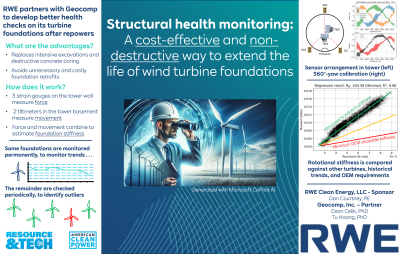Back

Foundation Health Check: Using Structural Health Monitoring to Estimate Turbine Foundation Stiffness and Consumed Lifetime
Tuesday, October 1, 2024
5:00 PM – 6:00 PM MST
Location: Regency D


Dan Courtney, PE
Manager, Civil Engineering
RWE Clean Energy
Chicago, Illinois
Poster Presenter(s)
Presentation Description: With the passage of the Inflation Reduction Act, partial repowers of existing wind farms have exploded in popularity. In these projects, when reusing the existing turbine foundations with new rotor assemblies, the extreme loads may still be acceptable, but the target project lifetime may be extended longer than what the foundations were originally designed for. Additionally, older turbine foundations may be at risk of pull-out failures driven by excessive fatigue loading, since the wind industry did not design for fatigue stresses as rigorously in the past as it does now.
For these reasons, RWE Clean Energy has developed a structural health monitoring program to provide a cost-effective health check on turbine foundations for which lifetime extension is desirable. The solution requires no destructive testing of the foundations, limited turbine downtime, and monitors foundation health across time and turbine population.
The objectives of the program are twofold: (1) to monitor foundation stiffness and catch fatigue damage early before it creates operational or safety issues, and (2) to correlate measured foundation stiffness with existing turbine wind speed & power statistics so that consumed and remaining lifetime of turbine foundations may be better estimated.
RWE has completed its first iteration of a structural health monitoring program at one of its repowered wind farms and hopes to share lessons learned and best practices as it expands the program to other sites being repowered or undergoing lifetime extensions.
For these reasons, RWE Clean Energy has developed a structural health monitoring program to provide a cost-effective health check on turbine foundations for which lifetime extension is desirable. The solution requires no destructive testing of the foundations, limited turbine downtime, and monitors foundation health across time and turbine population.
The objectives of the program are twofold: (1) to monitor foundation stiffness and catch fatigue damage early before it creates operational or safety issues, and (2) to correlate measured foundation stiffness with existing turbine wind speed & power statistics so that consumed and remaining lifetime of turbine foundations may be better estimated.
RWE has completed its first iteration of a structural health monitoring program at one of its repowered wind farms and hopes to share lessons learned and best practices as it expands the program to other sites being repowered or undergoing lifetime extensions.
